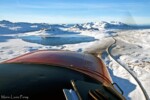Iceland’s most challenging airports – Vestmannaeyjar (BIVM) (1/5)
25 February 2018 | Updated on February 05, 2024
Welcome to Vestmannaeyjar, 63°25′30″N 020°16′45″W, and home to one of Iceland’s most challenging fly-in!
BIVM sits on the island of Heimaey, located 4 nm off the south coast of the main island. It is the archipelago’s biggest and only inhabited grounds, surrounded by honeycombed walls of puffin nests, hyperactive volcano cones, and the glacially high waves of the Atlantic ocean bathing in a subpolar oceanic climate.
It’s sublime in daylight, enthralling at sundown and eerie at night.
The airport itself features two asphalt-stabilized gravel runways 03-21 and 12-30, with a respective slope of 0.2% and 0.7%. The light slope remains comfortable in both cases, occasionally bringing some positivity into the landing should the edge and center lines play trick to the eyes!
Runway 30 is particularly famous for the 90m-steep cliff fringing the threshold, a real arcade game in three-dimensions. The islands born from this volcanic hotpot are sandwiched in alternating layers of tuff and lava, their crispy crusts on display as soon as they rise over the water. All eyes are immediately drawn to the geological ground-show below, and as soon as the airplane breaks through the clouds, this Pandora box shines dauntingly with promises of shrills and delights.
In BIVM, departing from the glideslope quickly becomes critical, all variables coming briskly into play to create the siege for a head-on collision on approach and a quick sink into cold, rabid waters on departure or go-around. Both runways are over 1000 m long, enough for comfort, but never too much to forego staying alert.
The weather on this unknown little island is infamous, with records to break each time the polar depressions decide to spill down our coasts. Stórhöfði, a peninsula at the southernmost point of Heimaey, is claimed to be the windiest place in Europe, and holds the record for the lowest on land observation of air pressure on our continent (2 December 1929 – 923.6 hPa). (By the way, Stórhöfði, “black cape” is the Icelandic term for Darth Vader. The Force is definitely strong down there!).
With 20+ knots an everyday climatic expectation, gusts over 50 as soon as Njord awakes, 70 and above in the dead of winter, bumps are in the air on this basaltic Death Star replica!
Crowned by the crests of the Southern Icelandic Volcanic Zone, the final for 30 (and to a lesser extent, 03) can become particularly turbulent. Caught swinging in rotors, an argentic world tumbling upside down, every pilot synaptic bridge firing bright, it takes healthy doses of skills, and manic shots of fun, to glide your bird onto the asphalt.
Departing on a misty morning, or a bright wintery night, BIVM will also surprise by its aura of calm and quietness. With stars above and glitters below, we drift back towards the Icelandic capital feeling like pioneers who’ve just discovered a brand-new world.
Instagram: @introspections.nomades
Blog:66 degrees high










































